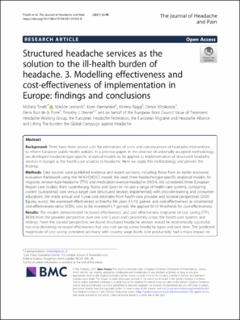| dc.contributor.author | Tinelli, Michela | |
| dc.contributor.author | Leonardi, Matilde | |
| dc.contributor.author | Paemeleire, Koen | |
| dc.contributor.author | Mitsikostas, Dimos-Dimitrios | |
| dc.contributor.author | Ruiz de la Torre, Elena | |
| dc.contributor.author | Steiner, Timothy J. | |
| dc.date.accessioned | 2023-02-22T12:18:15Z | |
| dc.date.available | 2023-02-22T12:18:15Z | |
| dc.date.created | 2021-11-24T13:22:16Z | |
| dc.date.issued | 2021 | |
| dc.identifier.citation | The Journal of Headache and Pain. 2021, 22 1-23. | en_US |
| dc.identifier.issn | 1129-2369 | |
| dc.identifier.uri | https://hdl.handle.net/11250/3053262 | |
| dc.description.abstract | Background Health economic evaluations support health-care decision-making by providing information on the costs and consequences of health interventions. No universally accepted methodology exists for modelling effectiveness and cost-effectiveness of interventions designed to close treatment gaps for headache disorders in countries of Europe (or elsewhere). Our aim here, within the European Brain Council’s Value-of-Treatment project, was to develop headache-type-specific analytical models to be applied to implementation of structured headache services in Europe as the health-care solution to headache. Methods We developed three headache-type-specific decision-analytical models using the WHO-CHOICE framework and adapted these for three European Region country settings (Luxembourg, Russia and Spain), diverse in geographical location, population size, income level and health-care systems and for which we had population-based data. Each model compared current (suboptimal) care vs target care (delivered in accordance with the structured headache services model). Epidemiological and economic data were drawn from studies conducted by the Global Campaign against Headache; data on efficacy of treatments were taken from published randomized controlled trials; assumptions on uptake of treatments, and those made for Healthy Life Year (HLY) calculations and target-care benefits, were agreed with experts. We made annual and 5-year cost estimates from health-care provider (main analyses) and societal (secondary analyses) perspectives (2020 figures, euros). Results The analytical models were successfully developed and applied to each country setting. Headache-related costs (including use of health-care resources and lost productivity) and health outcomes (HLYs) were mapped across populations. The same calculations were repeated for each alternative (current vs target care). Analyses of the differences in costs and health outcomes between alternatives and the incremental cost-effectiveness ratios are presented elsewhere. Conclusions This study presents the first headache-type-specific analytical models to evaluate effectiveness and cost-effectiveness of implementing structured headache services in countries in the European Region. The models are robust, and can assist policy makers in allocating health budgets between interventions to maximize the health of populations. | en_US |
| dc.language.iso | eng | en_US |
| dc.publisher | BioMed Central | en_US |
| dc.rights | Navngivelse 4.0 Internasjonal | * |
| dc.rights.uri | http://creativecommons.org/licenses/by/4.0/deed.no | * |
| dc.title | Structured headache services as the solution to the ill-health burden of headache. 2. Modelling effectiveness and cost-effectiveness of implementation in Europe: methodology | en_US |
| dc.title.alternative | Structured headache services as the solution to the ill-health burden of headache. 2. Modelling effectiveness and cost-effectiveness of implementation in Europe: methodology | en_US |
| dc.type | Peer reviewed | en_US |
| dc.type | Journal article | en_US |
| dc.description.version | publishedVersion | en_US |
| dc.source.pagenumber | 1-23 | en_US |
| dc.source.volume | 22 | en_US |
| dc.source.journal | The Journal of Headache and Pain | en_US |
| dc.identifier.doi | 10.1186/s10194-021-01305-8 | |
| dc.identifier.cristin | 1958405 | |
| cristin.ispublished | true | |
| cristin.fulltext | original | |
| cristin.qualitycode | 1 | |

